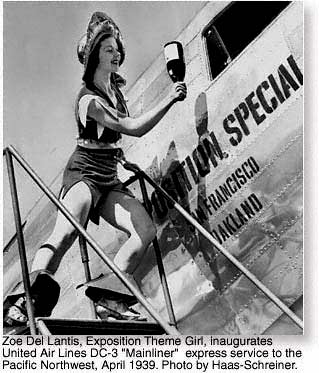Trails End for ’39ers
During the last decade the world’s two largest bridges have been flung across San Francisco Bay...and to celebrate their completion, the world’s largest man-made island now has risen from the waves.
 Beneath the level waters of the Bay is an uneven terrain down to 2 to 382 feet. Mariners long have avoided the treacherous shoals just north of Yerba Buena Island, in no place deeper than 26 feet. These watery acres were waste territory — until it was decided to create upon them the site of the Golden Gate International Exposition, to be known as Treasure Island during 1939 and thereafter to become an airport for the trans-Pacific clipper ships. Beneath the level waters of the Bay is an uneven terrain down to 2 to 382 feet. Mariners long have avoided the treacherous shoals just north of Yerba Buena Island, in no place deeper than 26 feet. These watery acres were waste territory — until it was decided to create upon them the site of the Golden Gate International Exposition, to be known as Treasure Island during 1939 and thereafter to become an airport for the trans-Pacific clipper ships.
Rock walls composed of 287,000 tons of quarried rock were sunk in the shoals. Twenty million cubic yards of sea bottom were dredged up and piled within the walls. When the sand was 13 feet above sea level, engineers “unsalted” it by a leaching process. Barges brought 50,000 cubic yards of loam from the mainland to enrich it. When the engineers finished, a 400-acre island, a mile long and two-thirds of a mile wide, had appeared in the Bay, connected by a 900-foot paved causeway to the Bay Bridge and equipped with ferry slips and landings for small craft and flying boats.
Meanwhile botanists were hunting through all the continents for unusual trees and plants. For many months orchids, hibiscus, datura, rare silver trees, orange trees, and palms were acclimated in a San Francisco plant hospital, where also are the electrically heated propagation beds that bring to bloom the plants to compose the ever-changing floral patterns of the Fair grounds. Horticultural plans call for planting 4,000 trees, 70,000 shrubs, and 700,000 flowering plants. To sprinkle the plants—and quench the thirst of visitors—San Francisco water was piped over the San Francisco-Oakland Bay Bridge to a 3,000,000-gallon reservoir cut in the solid rock of Yerba Buena Island.
With federal aid were commenced three permanent structures that later will serve the airport—the $800,000 administration building and the two $400,000 steel and concrete hangars, each 335 feet long and 78 feet high, used temporarily to house the $20,000,000 art exhibits and the foreign treasures loaned for the Fair. Finally, around these structures, began to rise a $50,000,000 fantasy — America’s World’s Fair on the Pacific.
The fair grounds are designed as a walled city, enclosing a series of connected courts. Although a primary consideration was to plan
step-saving routes across the 400 acres, the effect first noticed is the island’s beauty—its vistas of pools, gardens, and lagoons, bordered with exotic buildings representing the Pacific nations. Cambodian, Mayan, and Incan motifs give a charming strangeness to this modern Exposition “city.”
From the Central Court, where the Island’s two systems of avenues and courts intersect, rises the 400-foot Tower of the Sun. Northward the mile-long Avenue of the Seven Seas leads to the Court of Pacifica, portal to the Fair’s open-air pageant, the Cavalcade of the Golden West; southward, to the Port of the Trade Winds, anchorage for trade ships, junks, square riggers and yachts. The main cross-avenue leads to the central Court of Honor into the Court of the East and thence to the lake of All Nations, a lagoon overlooked by the $1,500,000 United States Government Building and exhibit area. At the north end of the island, next to the 12,000-car parking lot, lies the Gayway, a 40-acre fun zone, with its cyclone coaster, rocket ship, giant crane, and other thrill rides and shows.
In the exhibit pavilions, visitors will see a $1,000,000 “mineral mountain” of ore with miniature models showing gold mining operations and a $1,000,000 relief map of Western America—so large that the borders of the States can be traversed on foot paths. They will witness demonstrations of the electric eye, television, electronic music, atom-smashing, chemical agriculture. The latest sub-stratosphere transport planes—even Douglas Corrigan’s famed “Corrigan Crate”—will be on exhibition. Forty or more foreign nations will exhibit in the International Building and Pacific Nations’ Exhibit Area; the United States and nearly half the States of the Union, in the Federal Building and Hall of Western States; the State and Counties of California, in the California Building Group. A cross-section of American business and industry will be displayed in pavilions and exhibits valued at more than $15,000,000—the Halls of Varied Industries, Electricity and Communications, Foods and Beverages, Homes and Gardens, Mines, Metals, and Machinery, Science, and Vacationland. The Fair’s Gayway, a mile-long circular boulevard, will be lined with showplaces—the Chinese City, Hollywood Boulevard, Streets of the World, and many others.
The islands colors, stimulating, unforgettable, represent the first extensive application of chromotherapy—the science of health treatment by color usage. In the daytime the effects are gained with flowers and tinted walls; at night, with fluorescent tubes, with the new “black light,“ with ultra-violet floods, underwater lamps, translucent glass fabric pillars, and cylindrical lanterns 75 feet high. Some of the flower beds are played upon by artificial moonlight, others bathed in sunshine created out of neon and mercury. The $1,000,000 illumination program presents at nightfall the illusion of a magic city of light, floating on the waters of San Francisco Bay.
From: Almanac for Thirty-Niners
Compiled by the Workers of the Federal Writers’ Project of the
Works Progress Administration in the City of San Francisco — 1938.
Return to
top of page
|